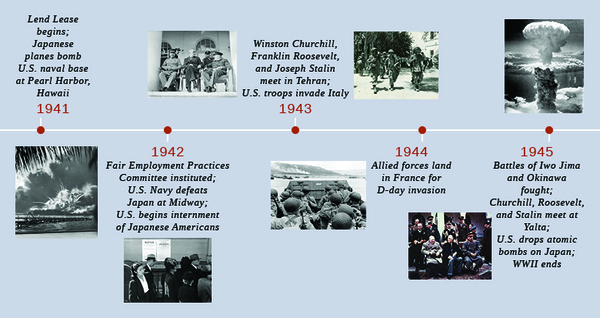| << Chapter < Page | Chapter >> Page > |

The years between the First and Second World Wars were politically and economically tumultuous for the United States and especially for the world. The Russian Revolution of 1917, Germany’s defeat in World War I, and the subsequent Treaty of Versailles had broken up the Austro-Hungarian, German, and Russian empires and significantly redrew the map of Europe. President Woodrow Wilson had wished to make World War I the “war to end all wars” and hoped that his new paradigm of “collective security” in international relations, as actualized through the League of Nations, would limit power struggles among the nations of the world. However, during the next two decades, America’s attention turned away from global politics and toward its own needs. At the same time, much of the world was dealing with economic and political crises, and different types of totalitarian regimes began to take hold in Europe. In Asia, an ascendant Japan began to expand its borders. Although the United States remained focused on the economic challenges of the Great Depression as World War II approached, ultimately it became clear that American involvement in the fight against Nazi Germany and Japan was in the nation’s interest.
While during the 1920s and 1930s there were Americans who favored active engagement in Europe, most Americans, including many prominent politicians, were leery of getting too involved in European affairs or accepting commitments to other nations that might restrict America’s ability to act independently, keeping with the isolationist tradition. Although the United States continued to intervene in the affairs of countries in the Western Hemisphere during this period, the general mood in America was to avoid becoming involved in any crises that might lead the nation into another global conflict.
Despite its largely noninterventionist foreign policy, the United States did nevertheless take steps to try to lessen the chances of war and cut its defense spending at the same time. President Warren G. Harding’s administration participated in the Washington Naval Conference of 1921–1922, which reduced the size of the navies of the nine signatory nations. In addition, the Four Power Treaty, signed by the United States, Great Britain, France, and Japan in 1921, committed the signatories to eschewing any territorial expansion in Asia. In 1928, the United States and fourteen other nations signed the Kellogg-Briand Pact , declaring war an international crime. Despite hopes that such agreements would lead to a more peaceful world—far more nations signed on to the agreement in later years—they failed because none of them committed any of the nations to take action in the event of treaty violations.

Notification Switch
Would you like to follow the 'U.s. history' conversation and receive update notifications?